Illarion
Mikhailovich Pryanishnikov, a nice long Russian name. A great painter who died
in 1894. Before he died he finished this masterpiece, the "Easter Procession",
of 1893. Much more solemn than the next image. The
image evokes the religious devotion of the Russians, they were especially awed
by colors, icons and mysticism. Not many understood the teachings of the Scriptures.
They knew who Jesus Christ was/is: which is good. Images can be printed at 11
x 17 inches, for framing. I enhanced each carefully. Color is: AdobeRGB (1998) | | 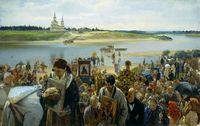
clcik
to view |
Ilya
Yefimovich Repin, another Russian artist. He was a native of the Ukraine, he died
in Finland in 1930. He was quite famous, with good reason. The Russians loved
him and his wonderful paintings. His paintings also evoked a sense of national
pride, and often depicted the common folks. He was well known as a portrait and
icon painter as well. Note the intrusion or oversight provided by the Russian
authorities present on horses! This
image too is an Easter procession - "Religious Procession in Kursk Province",
painted 1880 -1883. | | 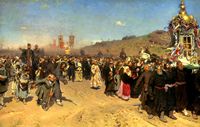
click
to view |
| Ivan
Nikolaevich Kramskoi, another Russian great. Died in 1887. Did not care for the
Russian Academic norms, so developed his own style. From a poor family. Though
no one knows what Jesus Christ looked like (other than Isaiah 53:2, he was not
handsome). This depiction is haunting. Jesus in the desert! One of my favorites,
note the similarity of the textures of the stone and the gaunt hardness of Christ's
skin! Would appear to be during one of His fasts. | | 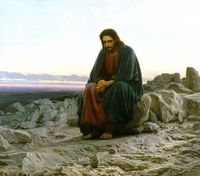
click
to view |
Alexei
Kondratyevich Savrasov, my final sample of great modern Russian religious artwork.
He died in 1897, his final years were drowned by alcoholism. He was most famous
for his landscapes. This image is of the Monastery near Nizhny Novgorod, the Pechorskiy
Monastery or Cloister, it is near a river, it has some underground caves/tunnels
as does the next item. Lower
image is another Monastery, the Pecherskaia Monastery (also called the Monastery
of Caves, and also spelled Pechersky). This monastery is located in Kiev. Some
websites confuse this Monastery with the one above. This monastery is the greatest
of the Kievan monasteries. Founded in circa A.D.
1040, by St. Anthonii, it has some tunnels extending beneath it to the nearby
Dnieper River. The front of this building was heavily damaged by the Germans in
WWII. Originally the monastery was closer to the river, but was moved during the
rule of its second abbot, St. Feodosii. The present buildings date from only the
17th century (rebuilt). IMAGE SOURCE: A History of Russia. Jesse D. Clarkson.
Random House. 1961. | | 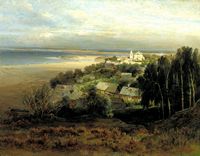
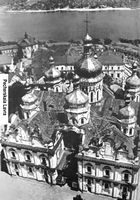
click
to view |
Upper
map showing rough locations of the great Bulgarian monasteries. Lower
map, via the experts at National Geographics (circa 1962). Bulgaria. Detailed. | | 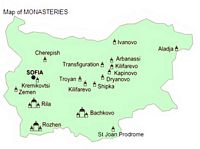
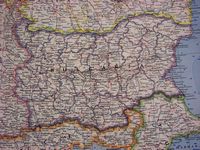
click
to view |
Maps
of Serbia, upper one shows locations of monasteries in the Fruska Gora area. Lower
map, from National Geographics (circa 1962). Detailed. Showing the same area of
Northern Serbia. | | 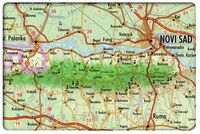
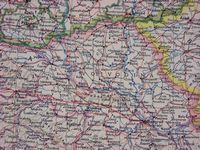
click
to view |
maps
showing some of the north central Monasteries of Romania. Middle
map is a detail of the upper region of Romania, where some monasteries are located. Lower
map again from the cartographics experts at the National Geographics Society (circa
1962). Detailed. All of Romania. | | 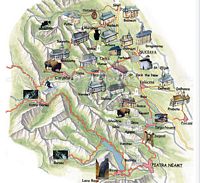

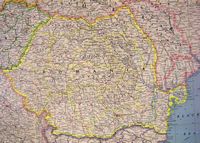
click
to view |
| Map
of Basil II's Byzantine empire, circa 1025 and later as well as earlier. Credit
on image. | | 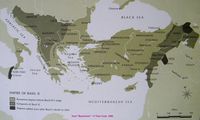
click
to view |
Map
illustrating several religious establishments in the Slavic world of A.D. 1050.
At this time it is evident that Roman Catholicism has destroyed much of the earlier
Pauline doctrines and early Byzantine plantings. Catholicism did follow the Roman
armies. After the Tatar invasions and those via the Golden Horde, and of the turks
of the 1400s, Orthodoxy again gains some control. Romania resisted the Ottoman
Turks of the 1400s and became a haven for manuscripts which were moved from the
Serbian and Bulgarian regions (which the Ottoman Muslim Turks devastated). Thus,
in Romania, we find surviving Old Bulgarian and Serbian MSS.. | | 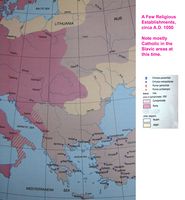
click
to view |
| map
illustrating the MAJOR Byzantine trade routes. Note that one route passes through
Serbia, Hungary et al. These routes also contributed to the spread of the New
Testament. Map does not show many minor Roman roads, such as all of the Via Egnatia,
which passes through Thessalonica and Croatia. Credit is given on image. | | 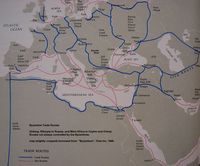
click
to view |
 click to
return to the main Slavonic Version _____page
click to
return to the main Slavonic Version _____page
| |  click to
jump to the main / index page
click to
jump to the main / index page |














